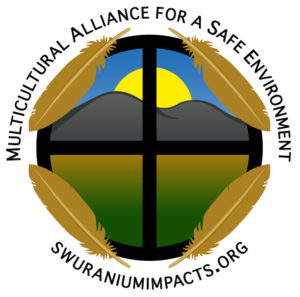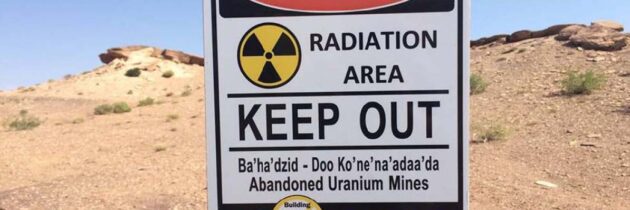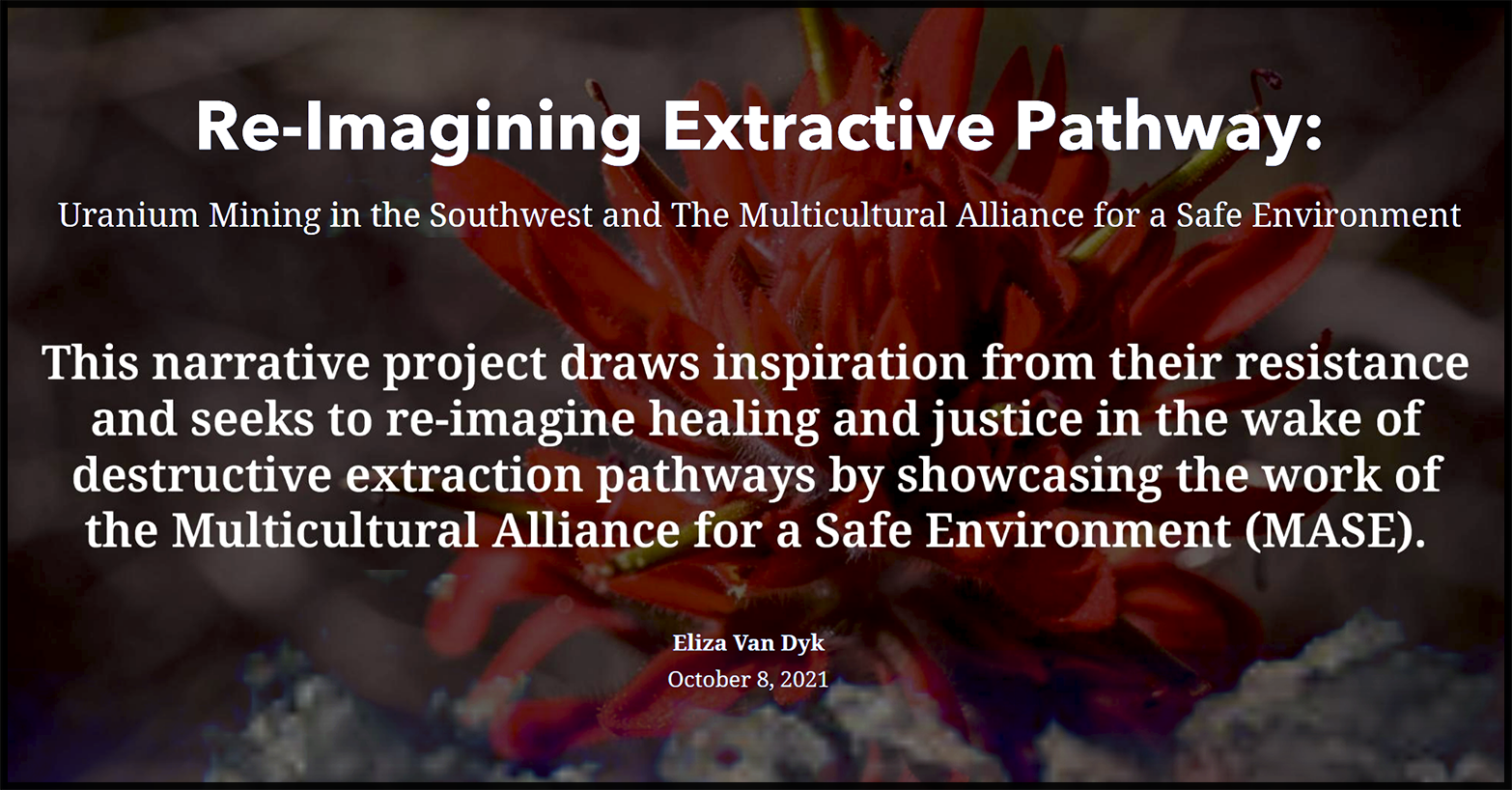Abandoned Uranium Mine Funding Sources
From 1944 to 1986, many Navajo people were employed at local uranium mines. Oftentimes, these workers lived and raised families near the mines and mills they were employed at. Today, there are over 500 abandoned uranium mines (AUMs) on the Navajo Nation, but their legacy remains. These mines have contaminated the land, nearby homes, people, and drinking water. Exposure to radionuclides in drinking water has potential health effects, including lung cancer (from inhalation of radioactive particles), bone cancer, and impaired kidney function.
The Navajo Nation Environmental Protection Agency, alongside the U.S. Environmental Protection Agency, has prioritized the cleanup of 46 mines based on gamma radiation levels, proximity to homes, and potential for water contamination identified in preliminary assessments. Detailed cleanup investigations has been completed at six mines and funds are available to conduct the cleanup investigations at an additional 25 mines. Urgent cleanup actions were conducted at five priority mines.
The U.S. Environmental Protection Agency has entered into enforcement agreements and settlements valued at over $1.7 billion to reduce the highest risks of radiation exposure to the Navajo people from AUMs. Funding is available for the assessment and clean-up process at 219 of the 523 AUMs, approximately 40%, on the Navajo Nation. The high priority mines were selected by size and threat to human health (by distance to homes, potential for contamination by wind and water, and other criteria).
Settlements
Tronox
USEPA and Navajo Nation “led claims against Tronox, corporate successor to Kerr-McGee corporation, after Tronox “led for bankruptcy in 2009. Subsequently, the U.S., on behalf of the USEPA and other agencies, “led a lawsuit against Anadarko, another corporate successor of Kerr- McGee, for additional funding. The U.S. and others involved ultimately achieved a $5 billion national settlement in 2014, of which the USEPA received $900 million for the cleanup of more than 50 AUMs associated with Kerr-McGee. 42 of these AUMs occur on or near Navajo Nation. USEPA received an additional $90 million to address the Quivira mine alone. Funds allocated to USEPA are mandated by court to be spent by USEPA to address contamination at Navajo Nation AUMs.
Of the $5 billion settlement, the Navajo Nation received $44 million.
Cyprus Amax And Western Nuclear Consent Decree
The U.S., on behalf of the USEPA and other federal agencies, entered into a settlement with Cyprus Amax and Western Nuclear, a#liated subsidiaries of Freeport-McMoRan, in 2017 for the clean up of 94 AUMs on the Navajo Nation. This settlement is unique in that it requires Cyprus Amax and Western Nuclear to perform the work. Private parties like Cyprus Amax usually hire contractors to conduct the work for them.
The U.S. will pay approximately half of all costs, including the USEPA and the Navajo Nation EPA oversight costs, through a trust funded at $335 million. Cyprus Amax and Western Nuclear will fund the other half of the cost, giving the settlement an estimated total value of $600 million.
Phase I Settlement
The U.S. and Navajo Nation reached an agreement for the U.S. to fund the assessment of 16 priority AUMs on the Navajo Nation. The U.S. funded a trust in 2015 for the amount of $13 million. A trustee administers the trust by hiring contractors to perform the work. The trustee, Sadie Hoskie, was the “rst Executive Director of the Navajo Nation EPA and a former USEPA Region 8 Program Director prior to her retirement in 2015. A website for the trust can be found here: http://www.navajoaumtrust.org/.
Phase II Settlement
The U.S. and the Navajo Nation reached another agreement for the U.S. to fund another trust for the cleanup of the 16 priority mines assessed in the Phase I settlement and to evaluate 30 more AUMs located across the Navajo Nation. This trust will also fund groundwater and surface water studies at two mines. The trust has been initially funded for over $8.5 million. Like the Phase I settlement, a trustee will administer the trust by hiring contractors to perform the work. The trustee for the Phase II Removal Site Evaluation (RSE) Trust, Derrith Watchman-Moore, is a former business owner, Deputy Regional Director and Branch Chief of the BIA, and former Director of the Navajo Nation Oil & Gas Company. A website for the Trust can be found here: https://www.navajoaumtrust2.org/
Enforcement Agreements
USEPA entered into enforcement agreements with seven parties to assess contamination or take other removal actions at 37 AUMs, and to install interim safety measures such as fencing and signage. These parties are: Babbitt Ranches, BNSF, El Paso Natural Gas Company, Homestake, United Nuclear Corporation, and EnPro Holdings. Each agreement varies in scope and dollar amount for the work, but the USEPA intends to follow-up with agreements for cleanup as necessary. Ongoing efforts include identifying companies responsible for AUMs on the Navajo Nation and engaging them to assess and clean up these mines.
BABBITT RANCHES
Under a September 21, 2016 Administrative Order on Consent (AOC), Babbitt Ranches, LLC and C.O. Bar, Inc. agreed to conduct Removal Site Evaluations (RSEs) on two AUMs located on their property. Under this agreement, the companies also agreed to pay USEPA $230,000 in past incurred costs as well as future oversight costs. The two AUMs that Chevron will assess are part of a group of three AUMs known as the “Section 9 Lease Mines,” located about 10 miles southeast of Cameron, Arizona.
BNSF
Under a May 22, 2017 AOC, BNSF Railway Company (“BNSF”) agreed to conduct RSEs, address safety hazards, and conduct local outreach at the Haystacks Mine site. The Haystacks Mine site is a group of three AUMs near Prewitt, New Mexico in Baca/Prewitt Chapter of the Navajo Nation. This 174-acre area is currently used for livestock grazing and includes at least one residence.
CHEVRON
Under a July 28, 2011 AOC, Chevron U.S.A., Inc. (“Chevron”), corporate successor of Gulf Mineral Resources Company, will assess contamination and address safety hazards at the Mariano Lake Mine. Mariano Lake Mine, formerly known as Old Gulf Mine, is about 31 acres and contains about 250,000 cubic yards of soil containing radium and uranium at levels that could post a health risk if not addressed. Chevron completed the RSE in 2013. As of January 30, 2017, Chevron is conducting an Engineering Evaluation/Cost Analysis to evaluate options to address the soil contamination.
EL PASO NATURAL GAS COMPANY
Under an August 5, 2013 AOC and subsequent modification on June 28, 2017, El Paso Natural Gas Company (“EPNG”) will assess contamination and address safety hazards at 19 mine claims in the Western Navajo Agency. These mines are generally located along the Little Colorado River of Highway 89 near Cameron, Arizona. EPNG also agreed to complete RSEs at two priority mines, Charles Huskon No. 12 and
HOMESTAKE
Under an August 27, 2014 AOC, Homestake Mining Company of California (“Homestake”) will assess contamination and address safety hazards at four AUMs in the Mariano Lake and Smith Lake areas on the Navajo Nation. USEPA and the Navajo Nation EPA will oversee the work, totaling about $500,000. Under the agreement, Homestake will also set aside funds for USEPA’s oversight of future clean-up.
UNITED NUCLEAR CORPORATION
Under an April 27, 2015 AOC, United Nuclear Corporation (UNC) agreed to complete a design of a repository at the UNC Mill for the waste at the Northeast Church Rock Mine Site. The final design is expected to be completed in 2018. Subsequently, UNC will make a request to the U.S. Nuclear Regulatory Commission (NRC) to begin construction. The request and approval process will take two to five years. If the NRC approves the request, the USEPA would then negotiate a legal agreement with UNC to construct the repository, which would take about four years. Approximately one million cubic yards of mine waste will be removed from the mine site and consolidated in this repository.
ENPRO HOLDINGS
Under a January 8, 2018 AOC, EnPro Holdings, corporate successor of A&B Mining Corporation, will assess contamination and address safety hazards at eight AUMs near Tuba City and Cameron, Arizona. Two of these eight mines are considered high priority AUMs, based on their radiation levels, proximity to homes, and potential for water contamination. EnPro Holdings also agreed to pay $500,000 in USEPA oversight costs.
Sources:
1 (USEPA, 2018). U.S. Environmental Protection Agency. 2018. “Cleaning Up Abandoned Uranium
Mines.” <https://www.epa.gov/navajo-nation-uranium-cleanup/cleaning-abandoned-uraniummines>.
(Date Accessed: July 12, 2018).
2 (USEPA, 2018). U.S. Environmental Protection Agency. 2018. “Tronox Abandoned Uranium
Mines.” <https://www.epa.gov/navajo-nation-uranium-cleanup/tronox-abandoned-uraniummines>.
(Date Accessed: July 12, 2018).
3 (USEPA, 2018). U.S. Environmental Protection Agency. 2018. “Trust Mines.”
<https://www.epa.gov/navajo-nation-uranium-cleanup/trust-mines>. (Date Accessed: July 12,
2018).
4 (USEPA, 2018). U.S. Environmental Protection Agency. 2018. “Western Abandoned Uranium
Mine Region.” <https://www.epa.gov/navajo-nation-uranium-cleanup/western-abandoneduranium-
mine-region>. (Date Accessed: July 12, 2018).
5 (USEPA, 2018). U.S. Environmental Protection Agency. 2018. “Eastern Abandoned Uranium Mine
Region.” <https://www.epa.gov/navajo-nation-uranium-cleanup/eastern-abandoned-uraniummine-
region>. (Date Accessed: July 12, 2018).
6 (USEPA, 2017). U.S. Environmental Protection Agency. January 17, 2017. “Cleanup of 94
Abandoned Uranium Mines on the Navajo Nation.” <
https://archive.epa.gov/epa/newsreleases/justice-department-epa-and-navajo-nation-announcesettlement-
cleanup-94-abandoned.html>. (Date Accessed: July 12, 2018).






